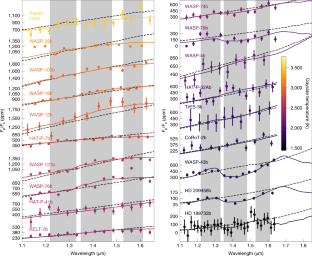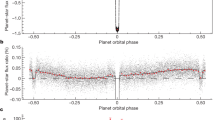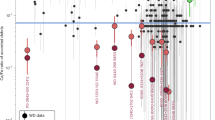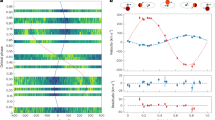Abstract
The emergent spectra of close-in, giant exoplanets (‘hot Jupiters’) are expected to be distinct from those of self-luminous objects with similar effective temperatures because hot Jupiters are primarily heated from above by their host stars rather than internally from the release of energy from their formation1. Theoretical models predict a continuum of dayside spectra for hot Jupiters as a function of irradiation level, with the coolest planets having absorption features in their spectra, intermediate-temperature planets having emission features due to thermal inversions and the hottest planets having blackbody-like spectra due to molecular dissociation and continuum opacity from the H− ion2,3,4. Absorption and emission features have been detected in the spectra of a number of individual hot Jupiters5,6, and population-level trends have been observed in photometric measurements7,8,9,10,11,12,13,14,15. However, there has been no unified, population-level study of the thermal emission spectra of hot Jupiters as there has been for cooler brown dwarfs16 and transmission spectra of hot Jupiters17. Here we show that hot Jupiter secondary eclipse spectra centred around a water absorption band at 1.4 μm follow a common trend in water feature strength with temperature. The observed trend is broadly consistent with model predictions for how the thermal structures of solar-composition planets vary with irradiation level, but is inconsistent with the predictions of self-consistent one-dimensional models for internally heated objects. This is particularly the case because models of internally heated objects show absorption features at temperatures above 2,000 K, whereas the observed hot Jupiters show emission features and featureless spectra. Nevertheless, the ensemble of planets exhibits some degree of scatter around the mean trend for solar-composition planets. The spread can be accounted for if the planets have modest variations in metallicity and/or elemental abundance ratios, which is expected from planet formation models18,19,20,21.
This is a preview of subscription content, access via your institution
Access options
Access Nature and 54 other Nature Portfolio journals
Get Nature+, our best-value online-access subscription
$29.99 / 30 days
cancel any time
Subscribe to this journal
Receive 12 digital issues and online access to articles
$119.00 per year
only $9.92 per issue
Buy this article
- Purchase on Springer Link
- Instant access to full article PDF
Prices may be subject to local taxes which are calculated during checkout




Similar content being viewed by others
Data availability
Data that support this paper’s findings and its plots are available on GitHub at https://github.com/meganmansfield/HSTeclipse. The full model grid can be found at https://www.dropbox.com/sh/gfsmqlxs6l1p0st/AABXyRA9RlZawpsknXc9Ya7ra?dl=0. Source data are provided with this paper.
References
Showman, A. P., Tan, X. & Parmentier, V. Atmospheric dynamics of hot giant planets and brown dwarfs. Space Sci. Rev. 216, 139 (2020).
Fortney, J. J., Lodders, K., Marley, M. S. & Freedman, R. S. A unified theory for the atmospheres of the hot and very hot Jupiters: two classes of irradiated atmospheres. Astrophys. J. 678, 1419–1435 (2008).
Parmentier, V. et al. From thermal dissociation to condensation in the atmospheres of ultra hot Jupiters: WASP-121b in context. Astron. Astrophys. 617, A110 (2018).
Arcangeli, J. et al. H− opacity and water dissociation in the dayside atmosphere of the very hot gas giant WASP-18b. Astrophys. J. Lett. 855, L30 (2018).
Kreidberg, L. et al. A precise water abundance measurement for the hot Jupiter WASP-43b. Astrophys. J. Lett. 793, L27 (2014).
Mikal-Evans, T. et al. Confirmation of water emission in the dayside spectrum of the ultrahot Jupiter WASP-121b. Mon. Not. R. Astron. Soc. 496, 1638–1644 (2020).
Beatty, T. G. et al. Spitzer and z′ secondary eclipse observations of the highly irradiated transiting brown dwarf KELT-1b. Astrophys. J. 783, 112 (2014).
Triaud, A. H. M. J., Lanotte, A. A., Smalley, B. & Gillon, M. Colour–magnitude diagrams of transiting exoplanets – II. A larger sample from photometric distances. Mon. Not. R. Astron. Soc. 444, 711–728 (2014).
Kammer, J. A. et al. Spitzer secondary eclipse observations of five cool gas giant planets and empirical trends in cool planet emission spectra. Astrophys. J. 810, 118 (2015).
Zhou, G. et al. Secondary eclipse observations for seven hot-Jupiters from the Anglo-Australian telescope. Mon. Not. R. Astron. Soc. 454, 3002–3019 (2015).
Keating, D., Cowan, N. B. & Dang, L. Uniformly hot nightside temperatures on short-period gas giants. Nat. Astron. 3, 1092–1098 (2019).
Beatty, T. G. et al. Spitzer phase curves of KELT-1b and the signatures of nightside clouds in thermal phase observations. Astron. J. 158, 166 (2019).
Baxter, C. et al. A transition between the hot and the ultra-hot Jupiter atmospheres. Astron. Astrophys. 639, A36 (2020).
Garhart, E. et al. Statistical characterization of hot Jupiter atmospheres using Spitzer’s secondary eclipses. Astron. J. 159, 137 (2020).
Dransfield, G. & Triaud, A. H. M. J. Colour–magnitude diagrams of transiting exoplanets – III. A public code, nine strange planets, and the role of phosphine. Mon. Not. R. Astron. Soc. 499, 505–519 (2020).
Manjavacas, E. et al. Cloud Atlas: Hubble Space Telescope near-infrared spectral library of brown dwarfs, planetary-mass companions, and hot Jupiters. Astron. J. 157, 101 (2019).
Sing, D. K. et al. A continuum from clear to cloudy hot-Jupiter exoplanets without primordial water depletion. Nature 529, 59–62 (2016).
Mordasini, C., van Boekel, R., Mollière, P., Henning, T. & Benneke, B. The imprint of exoplanet formation history on observable present-day spectra of hot Jupiters. Astrophys. J. 832, 41 (2016).
Ali-Dib, M. Disentangling hot Jupiters formation location from their chemical composition. Mon. Not. R. Astron. Soc. 467, 2845–2854 (2017).
Madhusudhan, N., Bitsch, B., Johansen, A. & Eriksson, L. Atmospheric signatures of giant exoplanet formation by pebble accretion. Mon. Not. R. Astron. Soc. 469, 4102–4115 (2017).
Cridland, A. J., van Dishoeck, E. F., Alessi, M. & Pudritz, R. E. Connecting planet formation and astrochemistry: a main sequence for C/O in hot exoplanetary atmospheres. Astron. Astrophys. 632, A63 (2019).
Tsiaras, A. et al. A population study of gaseous exoplanets. Astron. J. 155, 156 (2018).
Melville, G., Kedziora-Chudczer, L. & Bailey, J. Colour–colour and colour–magnitude diagrams for hot Jupiters. Mon. Not. R. Astron. Soc. 494, 4939–4949 (2020).
Lothringer, J. D., Barman, T. & Koskinen, T. Extremely irradiated hot Jupiters: non-oxide inversions, H− opacity, and thermal dissociation of molecules. Astrophys. J. 866, 27 (2018).
Kreidberg, L. et al. Global climate and atmospheric composition of the ultra-hot Jupiter WASP-103b from HST and Spitzer phase curve observations. Astron. J. 156, 17 (2018).
Mansfield, M. et al. An HST/WFC3 thermal emission spectrum of the hot Jupiter HAT-P-7b. Astron. J. 156, 10 (2018).
Piskorz, D. et al. Ground- and space-based detection of the thermal emission spectrum of the transiting hot Jupiter KELT-2Ab. Astron. J. 156, 133 (2018).
Zalesky, J. A., Line, M. R., Schneider, A. C. & Patience, J. A uniform retrieval analysis of ultra-cool dwarfs. III. Properties of Y dwarfs. Astrophys. J. 877, 24 (2019).
Lothringer, J. D. & Barman, T. The influence of host star spectral type on ultra-hot Jupiter atmospheres. Astrophys. J. 876, 69 (2019).
Thorngren, D., Gao, P. & Fortney, J. J. The intrinsic temperature and radiative–convective boundary depth in the atmospheres of hot Jupiters. Astrophys. J. Lett. 884, L6 (2019).
Parmentier, V., Showman, A. P. & Lian, Y. 3D mixing in hot Jupiters atmospheres. I. Application to the day/night cold trap in HD 209458b. Astron. Astrophys. 558, A91 (2013).
Beatty, T. G. et al. Evidence for atmospheric cold-trap processes in the noninverted emission spectrum of Kepler-13Ab using HST/WFC3. Astron. J. 154, 158 (2017).
Hubeny, I., Burrows, A. & Sudarsky, D. A possible bifurcation in atmospheres of strongly irradiated stars and planets. Astrophys. J. 594, 1011–1018 (2003).
Burningham, B. et al. Retrieval of atmospheric properties of cloudy L dwarfs. Mon. Not. R. Astron. Soc. 470, 1177–1197 (2017).
Brewer, J. M. & Fischer, D. A. C/O and Mg/Si ratios of stars in the solar neighborhood. Astrophys. J. 831, 20 (2016).
Greene, T. P. et al. Characterizing transiting exoplanet atmospheres with JWST. Astrophys. J. 817, 17 (2016).
Snellen, I. A. G., de Kok, R. J., de Mooij, E. J. W. & Albrecht, S. The orbital motion, absolute mass and high-altitude winds of exoplanet HD209458b. Nature 465, 1049–1051 (2010).
Brogi, M. & Line, M. R. Retrieving temperatures and abundances of exoplanet atmospheres with high-resolution cross-correlation spectroscopy. Astron. J. 157, 114 (2019).
Edwards, B. et al. ARES I: WASP-76 b, a tale of two HST spectra. Astron. J. 160, 8 (2020).
Fu, G. et al. The Hubble PanCET program: transit and eclipse spectroscopy of the strongly irradiated giant exoplanet WASP-76b. Astron. J. 162, 108 (2021).
Pluriel, W. et al. ARES. III. Unveiling the two faces of KELT-7 b with HST WFC3. Astron. J. 160, 112 (2020).
Kreidberg, L. et al. Clouds in the atmosphere of the super-Earth exoplanet GJ1214b. Nature 505, 69–72 (2014).
Horne, K. An optimal extraction algorithm for CCD spectroscopy. Publ. Astron. Soc. Pac. 98, 609–617 (1986).
Kreidberg, L. batman: BAsic Transit Model cAlculatioN in Python. Publ. Astron. Soc. Pac. 127, 1161 (2015).
Berta, Z. K. et al. The flat transmission spectrum of the super-Earth GJ1214b from Wide Field Camera 3 on the Hubble Space Telescope. Astrophys. J. 747, 35 (2012).
Nikolov, N. et al. Hubble PanCET: an isothermal day-side atmosphere for the bloated gas-giant HAT-P-32Ab. Mon. Not. R. Astron. Soc. 474, 1705–1717 (2018).
Foreman-Mackey, D., Hogg, D. W., Lang, D. & Goodman, J. emcee: the MCMC hammer. Publ. Astron. Soc. Pac. 125, 306 (2013).
Castelli, F. & Kurucz, R. L. in Modelling of Stellar Atmospheres Vol. 210 of IAU Symposium, A20 (eds Piskunov, N. et al.) (ASP, 2003).
Southworth, J., Bohn, A. J., Kenworthy, M. A., Ginski, C. & Mancini, L. A multiplicity study of transiting exoplanet host stars. II. Revised properties of transiting planetary systems with companions. Astron. Astrophys. 635, A74 (2020).
Wakeford, H. R., Sing, D. K., Evans, T., Deming, D. & Mandell, A. Marginalizing instrument systematics in HST WFC3 transit light curves. Astrophys. J. 819, 10 (2016).
Schwartz, J. C. & Cowan, N. B. Balancing the energy budget of short-period giant planets: evidence for reflective clouds and optical absorbers. Mon. Not. R. Astron. Soc. 449, 4192–4203 (2015).
Saumon, D. & Marley, M. S. The evolution of L and T dwarfs in color-magnitude diagrams. Astrophys. J. 689, 1327–1344 (2008).
Kitzmann, D. et al. The peculiar atmospheric chemistry of KELT-9b. Astrophys. J. 863, 183 (2018).
Toon, O. B., McKay, C. P., Ackerman, T. P. & Santhanam, K. Rapid calculation of radiative heating rates and photodissociation rates in inhomogeneous multiple scattering atmospheres. J. Geophys. Res. Atmos. 94, 16287–16301 (1989).
Husser, T.-O. et al. A new extensive library of PHOENIX stellar atmospheres and synthetic spectra. Astron. Astrophys. 553, A6 (2013).
McKay, C. P., Pollack, J. B. & Courtin, R. The thermal structure of Titan’s atmosphere. Icarus 80, 23–53 (1989).
Lupu, R. E. et al. The atmospheres of Earthlike planets after giant impact events. Astrophys. J. 784, 27 (2014).
Tennyson, J. et al. The 2020 release of the ExoMol database: molecular line lists for exoplanet and other hot atmospheres. J. Quant. Spectrosc. Radiat. Transf. 255, 107228 (2020).
Kurucz, R. & Bell, B. Atomic line data. Kurucz CD-ROM No. 23 (Smithsonian Astrophysical Observatory, 1995).
Gharib-Nezhad, E. & Line, M. R. The influence of H2O pressure broadening in high-metallicity exoplanet atmospheres. Astrophys. J. 872, 27 (2019).
Gharib-Nezhad, E. et al. EXOPLINES: molecular absorption cross-section database for brown dwarf and giant exoplanet atmospheres. Astrophys. J. Suppl. Ser. 254, 34 (2021).
Bell, K. L. & Berrington, K. A. Free-free absorption coefficient of the negative hydrogen ion. J. Phys. B 20, 801–806 (1987).
John, T. L. Continuous absorption by the negative hydrogen ion reconsidered. Astron. Astrophys. 193, 189–192 (1988).
Lacis, A. A. & Oinas, V. A description of the correlated-k distribution method for modelling nongray gaseous absorption, thermal emission, and multiple scattering in vertically inhomogeneous atmospheres. J. Geophys. Res. 96, 9027–9064 (1991).
Amundsen, D. S. et al. The UK Met Office global circulation model with a sophisticated radiation scheme applied to the hot Jupiter HD 209458b. Astron. Astrophys. 595, A36 (2016).
Gordon, S. & Mcbride, B. J. Computer Program for Calculation of Complex Chemical Equilibrium Compositions and Applications. Part 1: Analysis Technical Report No. 19950013764 (NASA Lewis Research Center, 1994).
Lodders, K., Palme, H. & Gail, H.-P. in Abundances of the Elements in the Solar System Vol. 4B (ed. Trumper, J. E.) 712 (Landolt-Börnstein, 2009).
Taylor, J. et al. How does thermal scattering shape the infrared spectra of cloudy exoplanets? A theoretical framework and consequences for atmospheric retrievals in the JWST era. Mon. Not. R. Astron. Soc. 506, 1309–1332 (2021).
Ackerman, A. S. & Marley, M. S. Precipitating condensation clouds in substellar atmospheres. Astrophys. J. 556, 872–884 (2001).
Mai, C. & Line, M. R. Exploring exoplanet cloud assumptions in JWST transmission spectra. Astrophys. J. 883, 144 (2019).
Zahnle, K., Marley, M. S., Morley, C. V. & Moses, J. I. Photolytic hazes in the atmosphere of 51 Eri b. Astrophys. J. 824, 137 (2016).
Roman, M. T. et al. Clouds in three-dimensional models of hot Jupiters over a wide range of temperatures. I. Thermal structures and broadband phase-curve predictions. Astrophys. J. 908, 101 (2021).
Parmentier, V., Showman, A. P. & Fortney, J. J. The cloudy shape of hot Jupiter thermal phase curves. Mon. Not. R. Astron. Soc. 501, 78–108 (2021).
Hunter, J. D. Matplotlib: a 2D graphics environment. Comput. Sci. Eng. 9, 90–95 (2007).
van der Walt, S., Colbert, S. C. & Varoquaux, G. The NumPy array: a structure for efficient numerical computation. Comput. Sci. Eng. 13, 22–30 (2011).
STScI Development Team. pysynphot: Synthetic photometry software package. Astrophysics Source Code Library ascl: 1303.023 (2013).
Virtanen, P. et al. SciPy 1.0: fundamental algorithms for scientific computing in Python. Nat. Methods 17, 261–272 (2020).
Acknowledgements
The work was based on observations made with the NASA/ESA Hubble Space Telescope that were obtained from the data archive at the Space Telescope Science Institute (STScI), which is operated by the Association of Universities for Research in Astronomy, Inc. under NASA contract NAS 5-26555. M.M. acknowledges funding from a NASA FINESST grant. M.R.L. acknowledges funding from NSF AST-165220, and NASA NNX17AB56G. M.R.L. also acknowledges opacity information from R. Lupu. M.R.L., J.L.B. and J.J.F. acknowledge funding for this work from STScI grants GO-13467 and GO-14792. J.J.F. and M.R.L. acknowledge the support of NASA grant 80NSSC19K0446. J.-M.D. acknowledges support from the Amsterdam Academic Alliance Program and from the European Research Council European Union’s Horizon 2020 research and innovation programme (grant no. 679633; Exo-Atmos). This work is part of the research programme VIDI New Frontiers in Exoplanetary Climatology with project number 614.001.601, which is (partly) financed by the Dutch Research Council.
Author information
Authors and Affiliations
Contributions
M.M. reduced and analysed the new data sets, led the data–model comparison and wrote the manuscript. M.R.L. created the self-consistent 1D exoplanet model grids and contributed to the writing of the manuscript. J.L.B. contributed to the conception of the population study and the writing of the manuscript. J.J.F. contributed to the interpretation of the results and the writing of the manuscript. L.W. created the self-consistent 1D self-luminous object model grids. V.P., E.M.-R.K., C.B. and J.-M.D. contributed to the interpretation of the results. E.G.-N. generated the opacities and absorption cross-sections for the 1D model grids. D.K.S. and M.L.-M. are principal investigators of the HST program GO-14767 from which we obtained the new observations that were analysed in this work. M.R.S. and G.M.R. contributed to the conception of the population study. All authors commented on the manuscript.
Corresponding author
Ethics declarations
Competing interests
The authors declare no competing interests.
Additional information
Peer review information Nature Astronomy thanks Elena Manjavacas, Amaury Triaud and the other, anonymous, reviewer(s) for their contribution to the peer review of this work.
Publisher’s note Springer Nature remains neutral with regard to jurisdictional claims in published maps and institutional affiliations.
Supplementary information
Supplementary Information
Supplementary Figs. 1–4 and Tables 1–6.
Source data
Source Data Fig. 1
.zip archive containing 19 .txt files, each of which contains one of the secondary eclipse spectra displayed in Fig. 1
Source Data Fig. 3
.zip archive containing four .txt files. Two of the .txt files contain the data points for hot Jupiters and brown dwarfs shown in Fig. 3. The other two .txt files contain the models for hot Jupiters and self-luminous objects shown in Fig. 3.
Rights and permissions
About this article
Cite this article
Mansfield, M., Line, M.R., Bean, J.L. et al. A unique hot Jupiter spectral sequence with evidence for compositional diversity. Nat Astron 5, 1224–1232 (2021). https://doi.org/10.1038/s41550-021-01455-4
Received:
Accepted:
Published:
Issue Date:
DOI: https://doi.org/10.1038/s41550-021-01455-4
This article is cited by
-
High atmospheric metal enrichment for a Saturn-mass planet
Nature (2023)
-
Methane throughout the atmosphere of the warm exoplanet WASP-80b
Nature (2023)
-
Revealing the atmospheres of highly irradiated exoplanets: from ultra-hot Jupiters to rocky worlds
Astrophysics and Space Science (2023)
-
Early Release Science of the exoplanet WASP-39b with JWST NIRISS
Nature (2023)
-
A broadband thermal emission spectrum of the ultra-hot Jupiter WASP-18b
Nature (2023)



